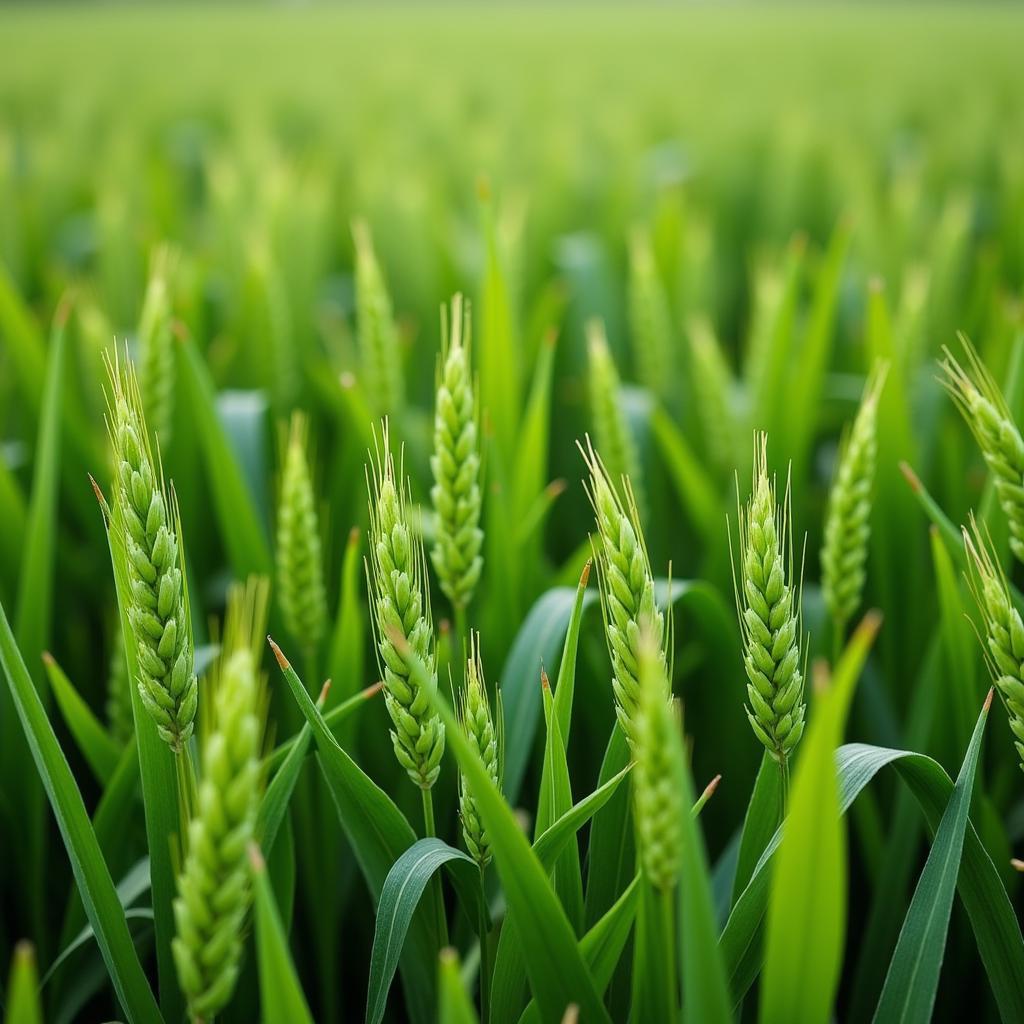Oats are a popular choice for food plots, offering a range of benefits for wildlife enthusiasts and hunters looking to attract deer and other game to their property. But are Oats For Food Plots right for you? In this comprehensive guide, we’ll explore the benefits, drawbacks, and best practices for planting oats for a thriving food plot.
Why Plant Oats in Your Food Plot?
Oats are a cool-season annual grain, which means they thrive in cooler temperatures and can be planted in both spring and fall. This makes them an incredibly versatile option for food plots, providing valuable forage during various times of the year.
Here are some key advantages of incorporating oats into your food plot strategy:
- High in Nutritional Value: Oats are an excellent source of carbohydrates, protein, and fiber, providing essential nutrients for deer and other wildlife, especially during crucial periods like antler growth and fawn rearing.
- Fast-Growing and Attractive: Oats establish quickly, creating a lush, green food source that’s highly attractive to deer. This rapid growth helps outcompete weeds and ensures your plot is productive in a short amount of time.
- Versatile Planting Options: As mentioned, oats can be planted in both spring and fall, allowing you to tailor your food plot to your specific hunting season and regional climate.
- Improve Soil Health: Oats are known to improve soil structure and fertility. Their extensive root systems help break up compacted soil, enhance drainage, and increase organic matter content.
 Oats Growing in a Food Plot
Oats Growing in a Food Plot
Choosing the Right Oat Variety for Your Food Plot
Selecting the appropriate oat variety is essential for maximizing the success of your food plot. Here are a few factors to consider:
- Maturity Rate: Opt for varieties with a maturity rate that aligns with your hunting season and desired grazing period. Early-maturing oats are ideal for fall plots, while later-maturing varieties are suitable for spring planting.
- Disease Resistance: Choose disease-resistant oat varieties to minimize the risk of crop loss due to common oat diseases.
- Cold Tolerance: In regions with harsh winters, select winter-hardy oat varieties that can withstand freezing temperatures and provide forage throughout the colder months.
Planting and Maintaining Your Oat Food Plot
To ensure a successful oat food plot, follow these essential planting and maintenance tips:
- Soil Testing and Preparation: Test your soil pH and nutrient levels before planting. Oats prefer well-drained soil with a pH between 6.0 and 6.5. Amend the soil as needed to create optimal growing conditions.
- Planting Time: Plant spring oats as soon as the ground can be worked in the spring. For fall planting, aim for 6 to 8 weeks before the first expected frost.
- Seeding Rate: The recommended seeding rate for oats in food plots is typically 50 to 80 pounds per acre. Adjust the seeding rate based on your chosen variety and soil conditions.
- Fertilization: Oats are heavy feeders and benefit from fertilization. Apply a balanced fertilizer according to soil test recommendations at the time of planting or as a top dressing.
- Weed Control: Control weeds early on to prevent competition with your oat seedlings. This can be achieved through herbicides, mowing, or a combination of both.
Oats in Food Plot Mixes: Expanding Your Options
While oats can be planted alone, they are often combined with other forage crops in food plot mixes. This strategy can extend the plot’s attractiveness, provide a wider range of nutrients, and attract a greater diversity of wildlife.
Here are some popular food plot mixes that include oats:
- Oats and Clover: This classic combination provides both cool-season and warm-season forage, extending the plot’s productivity throughout the year. Chicory and clover food plots are a great alternative for warmer climates or for extending the life of your plot.
- Oats and Winter Peas: This mix combines the high protein content of winter peas with the attractiveness and rapid growth of oats, creating a highly nutritious food source for the fall and winter months.
- Oats, Brassicas, and Ryegrass: This blend offers a diverse range of forages, including the cold tolerance of brassicas and the persistence of ryegrass, providing a food source that can last from fall through spring. For the best results, consider a best brassica food plot seed.
When choosing a food plot mix, consider the specific needs of the wildlife in your area, your budget, and the desired planting and hunting seasons. For comprehensive options tailored to your needs, explore our selection of food plot seed mix to find the perfect blend for your property.
Expert Insight: Tips from the Field
“Oats are a staple in my food plot program,” says wildlife biologist Sarah Jones. “They’re easy to establish, highly attractive to deer, and provide excellent nutrition. I particularly like using oats in fall plots, as they offer a readily available food source during the critical pre-rut and rut periods.”
Jones also emphasizes the importance of soil testing and proper plot preparation. “Even the best seed won’t perform well in poor soil conditions,” she cautions. “Invest the time to test your soil and make necessary amendments before planting.”
 Hunter in a Ground Blind Overlooking an Oat Food Plot
Hunter in a Ground Blind Overlooking an Oat Food Plot
Oats for Food Plots: A Rewarding Investment
Incorporating oats into your food plot strategy can be a game-changer for attracting and supporting wildlife on your property. By understanding the benefits, selecting the right varieties, and following proper planting and maintenance practices, you can create thriving oat food plots that enhance the hunting experience and contribute to the overall health of your local deer population.
Remember to choose high-quality best fall food plot seed to maximize your chances of success. And if you’re looking for a mix specifically formulated for deer, check out our selection of best deer food plot mixes.
Frequently Asked Questions (FAQs)
1. When is the best time to plant oats for deer?
The optimal planting time for oats depends on your region and whether you’re aiming for a spring or fall plot. Generally, spring oats are sown as soon as the ground can be worked, while fall oats are planted 6-8 weeks before the first frost.
2. How long does it take for oats to grow in a food plot?
Oats typically germinate within 5-10 days, and you can expect to see visible growth above the ground within a week or two after germination.
3. What animals are attracted to oat food plots?
Oats are highly attractive to whitetail deer, but they can also draw in other wildlife such as turkeys, rabbits, and even songbirds.
4. Can I plant oats in the same food plot every year?
While oats can be planted in the same location for a couple of years, it’s generally recommended to rotate your food plot crops to prevent soil depletion and disease buildup.
5. Do I need to fertilize my oat food plot?
Yes, oats are heavy feeders and benefit greatly from fertilization. Conduct a soil test to determine the specific nutrient requirements of your soil and apply a balanced fertilizer accordingly.
Need Help with Your Food Plots?
Contact us at 02437655121 or email minacones@gmail.com. Our team is available 24/7 to provide expert guidance. Visit us at 3PGH+8R9, ĐT70A, thôn Trung, Bắc Từ Liêm, Hà Nội, Việt Nam.
Explore More Food Plot Resources:
For more insights and tips on creating successful food plots, browse our collection of informative articles on our website.